In late July 2025, Amazon removed all Product Listing Ads from Google Shopping. Just like that, CPCs dropped, impressions opened up, and still, most performance dashboards barely moved.
The problem wasn’t the opportunity, but the speed to act. Marketers without feed visibility or rule-level agility are watching the moment pass while they wait on ops tickets and approval queues. Cheap clicks mean nothing if your catalog can’t seize them.

Google's Standards Didn't Leave With Amazon
If your feed couldn’t compete before, it definitely can’t now. Not in an auction that suddenly flooded with third-party sellers and legacy retailers eager to claim what Amazon left behind.
What changed:
- Scope: Only Shopping ads paused; Amazon’s text ads kept running.
- Auction vacuum: Walmart, Target, and Home Depot scooped 20% of the lost share within three days of Amazon’s pause (source: Heidi Sturrock).
- Pattern: Amazon ran a similar blackout in Q2, returned for Prime Day, and can flip back on anytime.
What didn’t change: Google’s product‑review checklist. Every SKU still gets evaluated against:
- GTIN accuracy and match to Google’s product graph
- Deep product_type taxonomy
- Variant structure and title coverage
- Price freshness, and availability
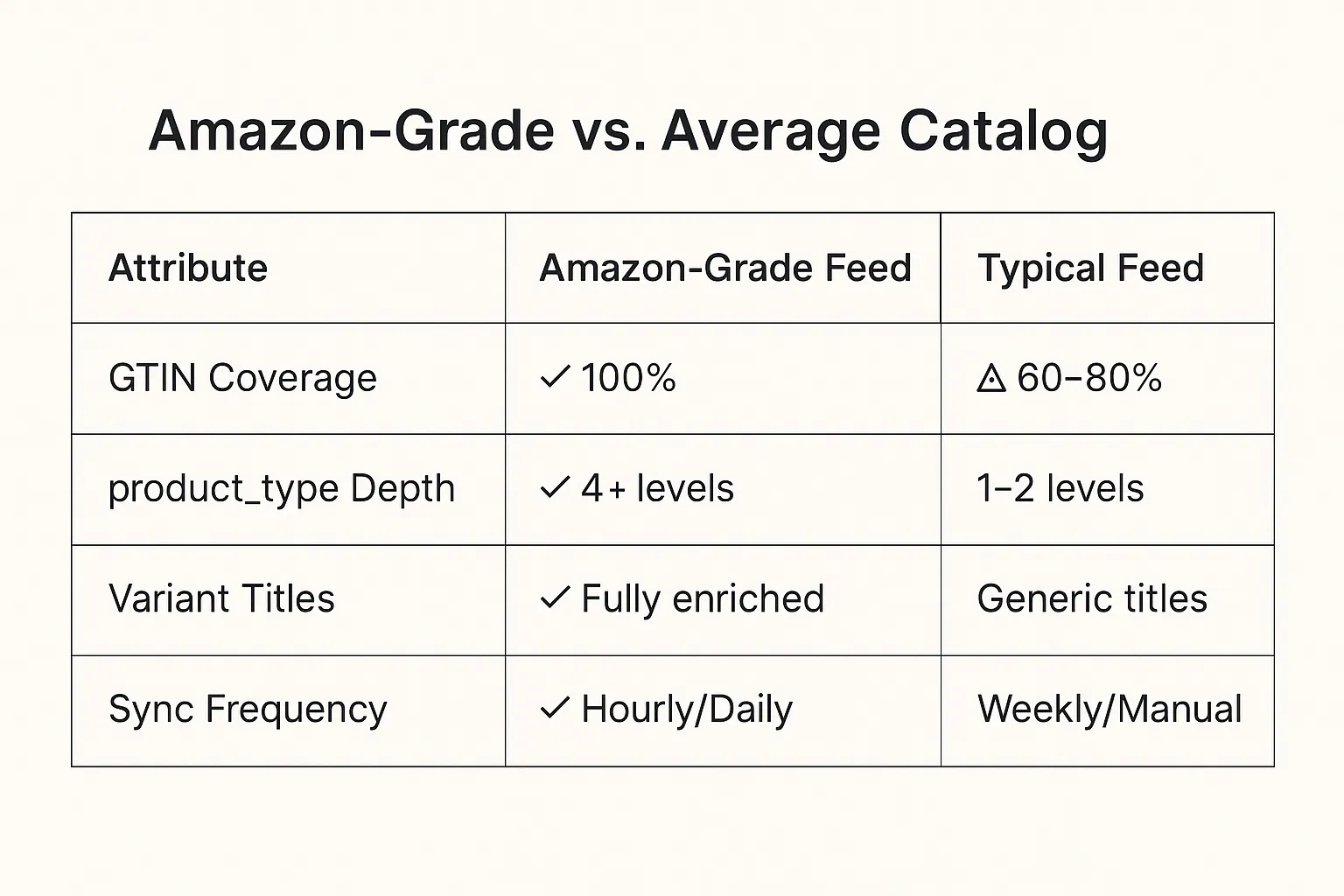
Amazon nailed it, but most catalogs still don’t. So when you hear “CPCs dropped but ROAS didn’t move,” what you’re really hearing is: Google made space, and the catalog wasn’t ready to fill it.
Feed Debt Symptom #1: You're Approved But Still Invisible
You know the scenario: products are approved in Merchant Center, but Auction Insights shows you’re getting 0.3% impression share on items you know should perform.
Fix the two biggest blockers:
Shallow Taxonomy Trees
Your product_type stops at "shoes" while Amazon goes "men > athletic > trail running > waterproof."
GoDataFeed rule:
IF product_type = "shoes" AND gender = "male" AND title CONTAINS "trail" OR description CONTAINS "trail"
THEN append " > men > trail running"
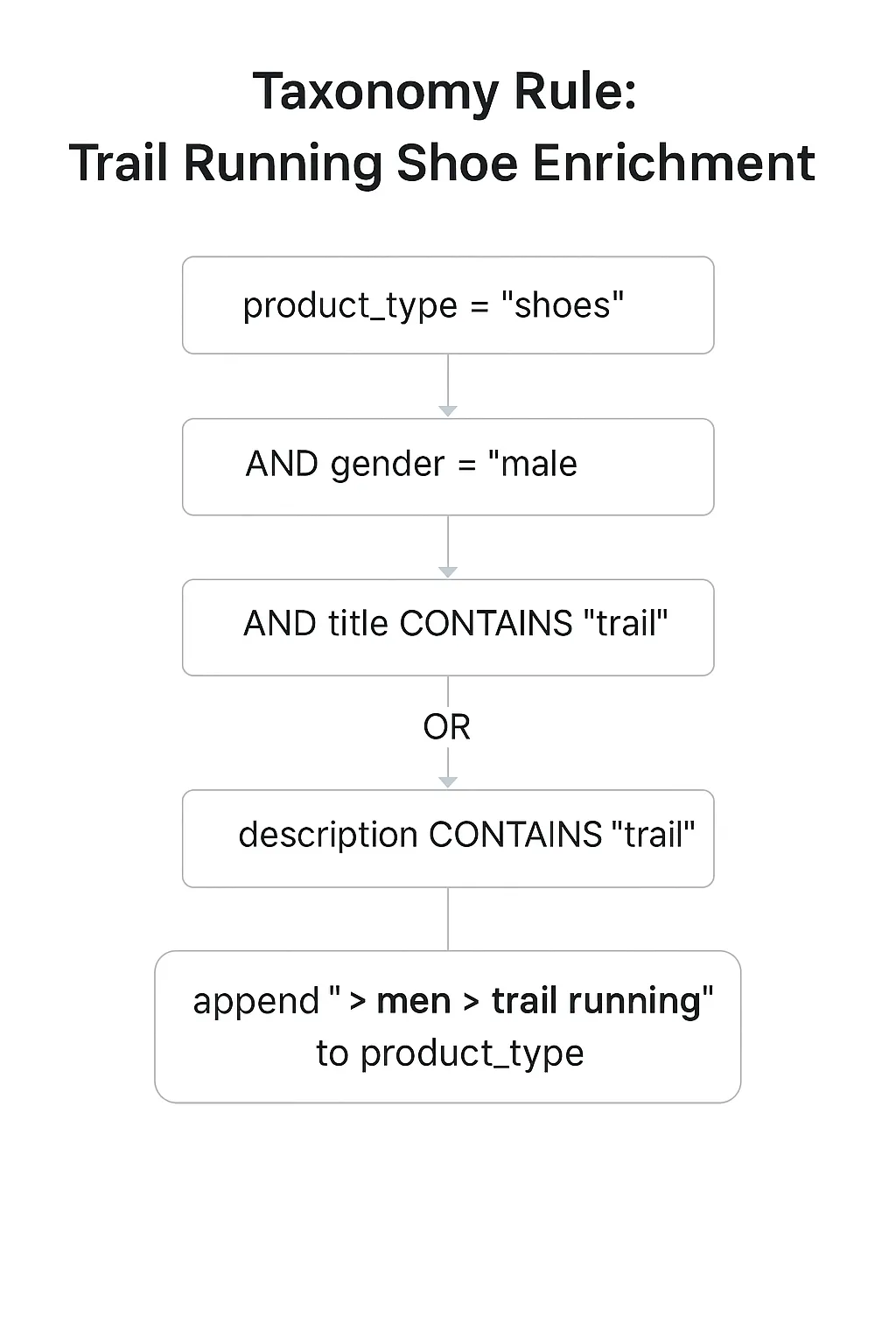
GTIN Coverage Under 90%
Without GTINs, you don’t match Google’s product graph, so you disappear on intent‑heavy queries like best trail shoes size 12.
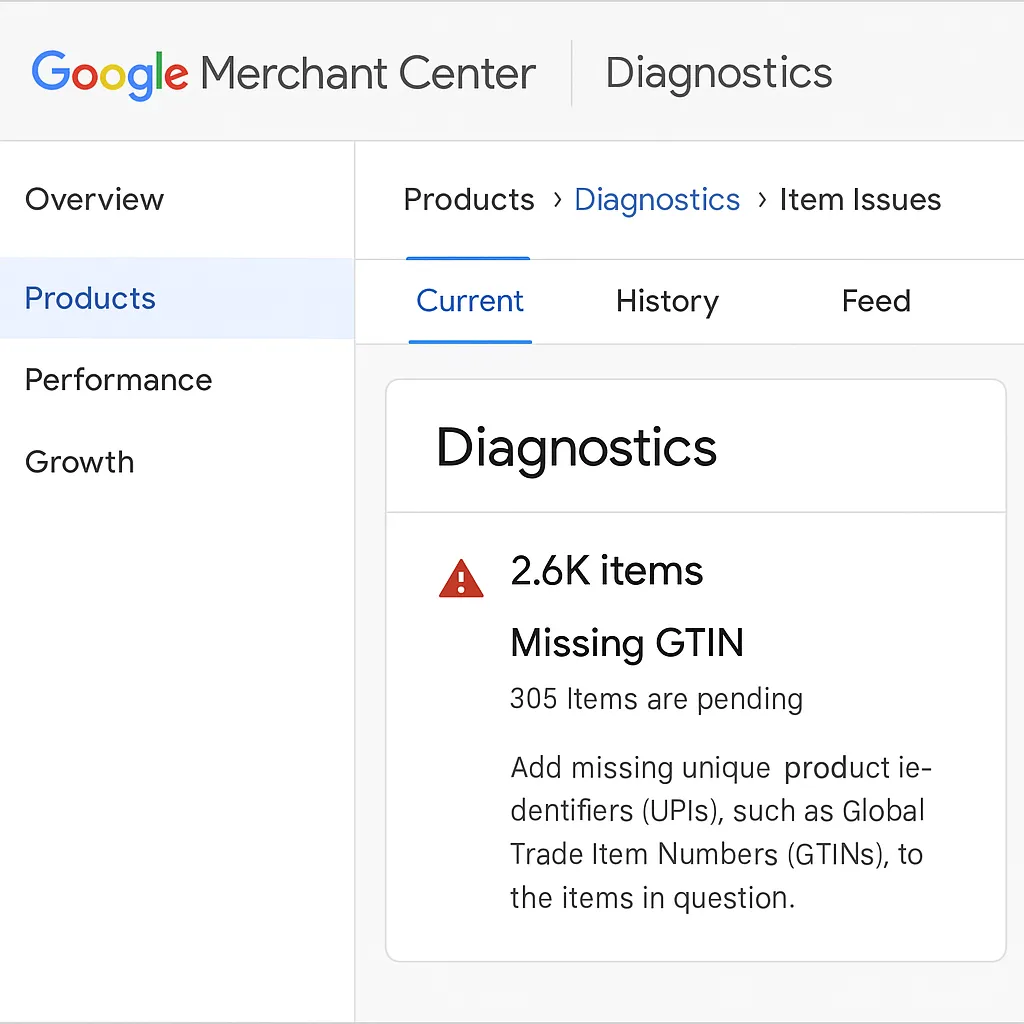
GoDataFeed rule:
IF gtin IS NULL
THEN map supplier_gtin
IF brand IS NULL
THEN brand = [brand_default]
How to check GTIN gaps:
- In Merchant Center, navigate to Diagnostics > Item issues > Missing GTIN
- Cross-check with Auction Insights to find suppressed high-intent SKUs
- Prioritize GTINs top 20% revenue-driving products
This works because Google relies on product_type depth and valid GTINs to surface products on queries that Amazon once dominated. Deeper breadcrumbs + clean identifiers restore eligibility before your competitors figure it out.
Feed Debt Symptom #2: Third-Party Seller Noise Is Killing Your CTR
When Amazon exited, thousands of marketplace sellers quickly created Shopping ads campaigns, often with exported, raw product data.
The result:
- Duplicate ads with generic titles competing against yours
- CTR erosion as Google rotates through low-relevance offers
- Performance Max widening scope to compensate for poor signals
This is where clean feeds can outperform messy ones almost immediately.
GoDataFeed rule:
IF is_variant = TRUE
THEN append [color] [size] to title
IF product_type CONTAINS "travel mug"
THEN custom_label_1 = "high_intent"
Push daily syncs to Merchant Center so your optimized titles outrank the generic flood. Clean feeds consistently outperform near-duplicates within 24 hours of refresh.
Performance Max Can't See the Gap Unless You Label It
PMax doesn't realize Amazon left. It's still leaning on asset-group signals that skew toward branded queries.
Mid-funnel terms like insulated water bottle 32oz are now wide open. But automation won't chase them without the right signals.
What works:
Custom labels tied to margin and intent.
IF margin < 20%
THEN custom_label_0 = "low_margin"
IF product_type CONTAINS "water bottle" AND title CONTAINS "insulated"
THEN custom_label_1 = "high_intent"
Then build separate asset groups:
- High-margin + high-intent → flexible ROAS target, extra budget.
- Low-margin fillers → Hold bid limits; let automation find efficiency
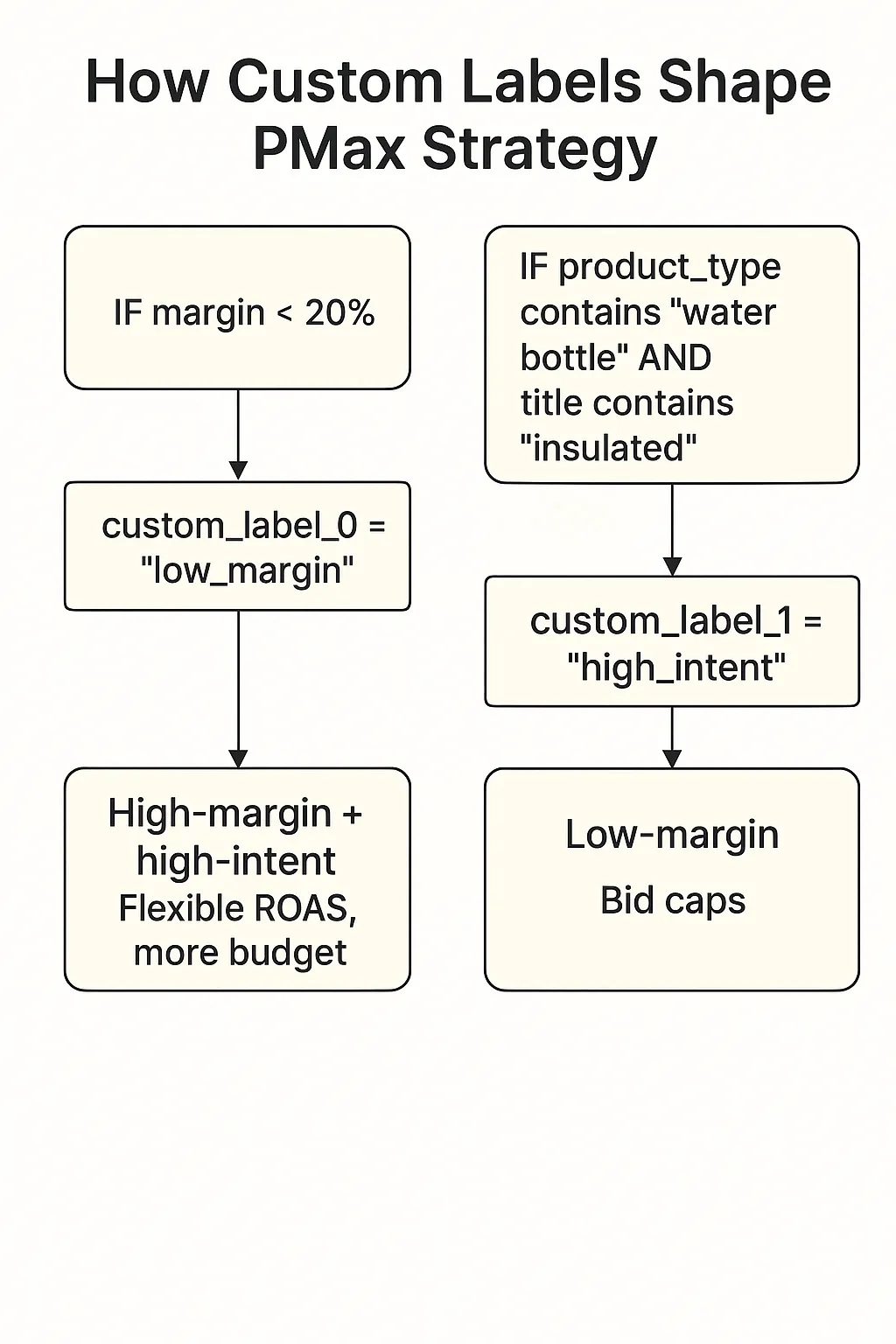
Teams running this split saw spend shift from branded to mid-funnel queries within 48 hours, with stronger conversion volume on the same budget.
Segment by ROAS to Stop Budget Waste
Google lowered bid floors, but your feed still sends every SKU to auction. Low-intent items siphon spend that should back proven converters.
Tighten the catalog:
- Export a 7-day SKU-level ROAS report from Google Ads.
- Flag the top-20 % revenue drivers with performance_flag = priority in your source feed.
- Rule in GoDataFeed:
IF performance_flag = "priority"
THEN custom_label_0 = "top_sku"
Isolate that group for Performance Max asset groups, flexible ROAS targets, or higher-volume bids. Everything else stays under tighter controls.
Pro tip: Give Merchant Center 24–48 h to reprocess, then check Auction Insights for the mid-funnel lift.
Before Amazon Flips the Switch Back: Multi-Channel Insurance
Amazon can re-enter Shopping ad auctions anytime. When they do, your cheap CPCs and expanded impression share vanish overnight.
Clone your optimized feed logic across channels:
- Microsoft Advertising (Bing Shopping) – often adds ~5–10 % incremental volume and accepts Google-formatted feed specs.
- Meta Advantage+ Catalog Ads – social reach; leverages product‑level signals you just perfected.
- TikTok Shop Ads – commerce placements feeding on structured data.
Export rules once and push live everywhere. Meta reports that retailers who mirrored their optimized feeds cut CPA by about 17 % in just two weeks.
Set a guardrail: When Amazon’s Shopping impression share in your category tops 10 %, restore pre‑exit CPC ceilings.
Your Catalog Either Speaks Google's Language or it Doesn't
If 60% of the auction disappeared and your KPI’s barely moved, the issue isn't bids, but your product data. Fix the catalog, and own the gap.
Ready to turn Amazon's absence into your advantage? Book a feed audit and see where your catalog is leaking relevance. That's your fastest path to reclaiming visibility before Amazon swims back.
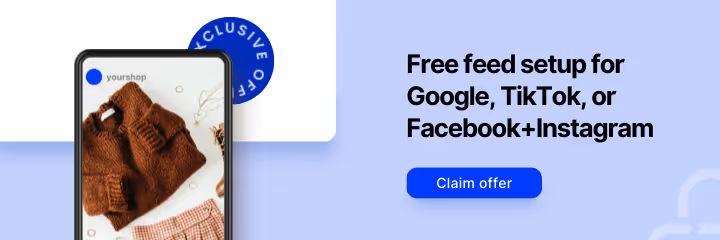





%20).webp)